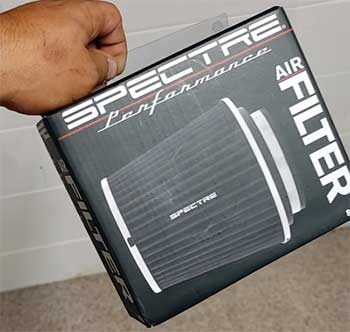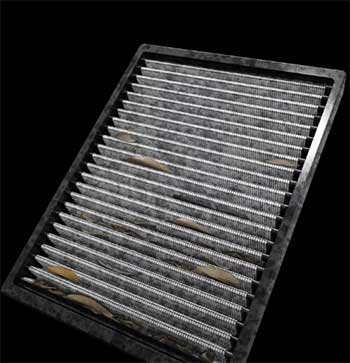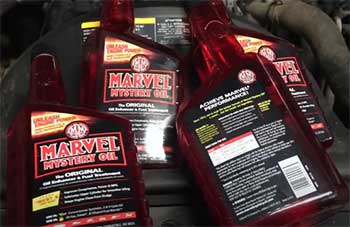As a car enthusiast tinkering with my ride, I’ve often faced the choice between Spectre and K&N air filters. Both brands promise better performance, but which one truly delivers?
In this article, I’ll break down their features, weigh their pros and cons, and share my insights from a hands-on perspective.
Whether you’re chasing horsepower or just want a reliable filter, I’ll help you decide what’s best for your vehicle. Let’s get under the hood and figure out which filter deserves a spot in your engine bay.
A Brief Comparison Table
| Feature | Spectre Air Filter | K&N Air Filter |
| Price (Average) | $20–$40 | $35–$80 |
| Filter Material | Synthetic, oiled | Cotton gauze, oiled |
| Warranty | Limited lifetime or 10 years | 10-year or 1 million miles |
| Maintenance | Washable, requires ~10 ml oil | Washable, requires ~49 ml oil |
| Horsepower Gain | 2–5 HP (estimated) | 3–7 HP (estimated) |
| Filtration Efficiency | Good, slightly less effective than K&N | Excellent, slightly better than Spectre |
| Installation | Easy, bolt-on with instructions | Easy, bolt-on with instructions |
| Durability | Moderate, thinner materials | High, robust construction |
| Brand Reputation | Budget-friendly, reliable | Premium, trusted by enthusiasts |
| Noise Level | Moderate intake sound | Aggressive intake sound |
Why Air Filters Matter To Me?
I’ve always been a bit obsessive about my car’s performance. Every tweak, from exhaust upgrades to air filters, feels like a personal victory. Air filters are the unsung heroes of an engine, balancing clean air delivery with maximum airflow.
A good filter can boost horsepower, improve throttle response, and even save fuel. But a bad one? It’s like choking your engine while letting dirt wreak havoc.
That’s why I’m pitting Spectre against K&N—two giants in the aftermarket world—to see which one earns its keep in my garage.
Spectre Air Filters: The Budget Champion

When I first stumbled across Spectre, I was drawn to the price tag.
At $20–$40, these filters are a steal compared to pricier competitors.
Spectre, around since 1983, markets itself as the “quality products that perform” brand.
Their air filters, often paired with cold air intake systems, use synthetic oiled media to trap dirt while letting air flow freely.
I’ve installed a Spectre filter on my old Civic, and the process was a breeze—clear instructions, no special tools, just a quick bolt-on job.
Key Features of Spectre Air Filters
- Synthetic Oiled Media: Spectre’s filters use synthetic material that’s oiled to catch dust and debris. It’s washable, so I don’t need to buy a new one every time it gets dirty.
- Affordable Pricing: At nearly half the cost of K&N, Spectre appeals to my wallet. For casual builds, this is a huge plus.
- Easy Installation: The included manual made swapping out my stock filter a 15-minute task. No mechanic required.
- Warranty Options: Depending on the model, Spectre offers a 10-year or limited lifetime warranty. That’s reassuring for a budget brand.
- Polished Aesthetics: Their chrome-finished intake tubes look sharp under the hood, giving my car a bit of flair.
Pros of Spectre Air Filters
- Cost-Effective: I saved a chunk of change compared to K&N, which let me splurge on other mods.
- Low Maintenance: Re-oiling takes just 10 ml of oil, and cleaning is straightforward. I’ve washed mine twice in two years with no hassle.
- Decent Performance: On my Civic, I noticed a slight kick in throttle response, likely adding 2–5 horsepower based on dyno estimates.
- Warranty Coverage: A 10-year or lifetime warranty gives me peace of mind, especially for the price.
- Beginner-Friendly: If you’re new to car mods, Spectre’s simple setup is forgiving and approachable.
Cons of Spectre Air Filters
- Build Quality: The materials feel a bit flimsy. The filter mesh is less rigid than K&N’s, and I’ve heard stories of filters collapsing under high RPMs.
- Filtration Trade-Off: Spectre’s filtration is solid but not top-tier. In dusty areas, I worry about fine particles slipping through.
- Performance Ceiling: For high-performance builds, Spectre’s gains plateau. My friend’s tuned WRX didn’t see much benefit.
- Brand Perception: Some enthusiasts call Spectre the “cheap knockoff.” While unfair, the stigma exists.
- Inconsistent Fitment: I’ve read forum posts about Spectre filters not fitting perfectly on certain trucks, though my Civic had no issues.
K&N Air Filters: The Premium Powerhouse

K&N has been the gold standard for performance air filters since the 1960s. At $35–$80, they’re a bigger investment, but their reputation is unmatched.
I’ve used K&N filters on my Mustang, and the aggressive intake growl alone made me grin.
K&N uses cotton gauze media, oiled for filtration, and their engineering is backed by NASCAR approval and rigorous dyno testing.
Installing one felt like upgrading to a premium product—sturdy, precise, and built to last.
Key Features of K&N Air Filters
- Cotton Gauze Media: K&N’s signature material balances airflow and filtration. It’s washable and reusable, cutting long-term costs.
- High Airflow Design: The low-restriction filter and custom tubing deliver up to 50% more airflow than stock filters, per K&N’s claims.
- Million-Mile Warranty: K&N’s 10-year or 1-million-mile warranty is industry-leading. I’ve never had to claim it, but it’s nice to know it’s there.
- Dyno-Tested Performance: K&N tests filters on chassis dynamometers, ensuring real-world gains. My Mustang felt peppier, likely gaining 3–7 horsepower.
- Robust Construction: The filter and tubing feel solid, with high-density polyethylene tubes that stay cooler than metal alternatives.
Pros of K&N Air Filters
- Superior Filtration: K&N’s cotton gauze catches more fine particles than Spectre, which is crucial if you drive in dusty conditions.
- Noticeable Performance: The extra airflow gave my Mustang a throatier sound and better acceleration, especially at higher RPMs.
- Longevity: With proper care, a K&N filter can last decades. I’ve had mine for five years, and it’s still going strong.
- Brand Prestige: K&N’s NASCAR pedigree and enthusiast trust make it a badge of quality. It’s the filter you brag about.
- Versatility: K&N offers filters for nearly every vehicle, from Hondas to heavy-duty trucks, with consistent performance.
Cons of K&N Air Filters
- Higher Cost: At double the price of Spectre, K&N stings the wallet. I had to skip a few coffee runs to afford it.
- Maintenance Demands: Re-oiling requires 49 ml of oil, and over-oiling can mess with your MAF sensor. I learned this the hard way.
- Noise Level: The aggressive intake sound is cool but can be too loud for daily drivers who prefer a quieter ride.
- Environmental Concerns: Cleaning and oiling produce waste, which might bother eco-conscious drivers.
- Overhyped Gains: While K&N delivers, the horsepower boost isn’t massive on stock engines. My friend’s stock Corolla barely noticed a difference.
Head-to-Head Comparison of Spectre And K&N Air Filters
Now that I’ve used both filters, let’s compare them across key areas that matter to me—and probably to you.
- Price and Value

Spectre’s affordability is hard to beat.
For $20–$40, I got a washable filter with decent performance and a solid warranty.
It’s perfect for budget builds or casual drivers who want a taste of performance without breaking the bank.
K&N, at $35–$80, feels like a luxury item.
The higher price buys better filtration, durability, and brand cachet, but the cost can feel steep if you’re not chasing every last horsepower.
For me, Spectre wins on value, but K&N justifies its price for serious enthusiasts.
- Performance and Horsepower
Both filters boost airflow, but K&N edges out Spectre. On my Mustang, K&N’s low-restriction design added a noticeable 3–7 horsepower, especially during hard pulls. Spectre’s 2–5 horsepower gain on my Civic was subtler, better suited for daily driving than track days.
Dyno tests from forums like BobIsTheOilGuy confirm K&N’s slight edge, though neither filter transforms a stock engine into a beast. If you’ve got a tuned or modified car, K&N’s extra airflow shines; for stock setups, Spectre’s gains are often enough.
- Filtration Efficiency
Filtration is where K&N pulls ahead. Its cotton gauze media traps finer particles, which is a big deal in dusty areas like where I live. A 2009 ISO 5011 test on Duramax filters showed K&N letting through slightly more dirt than OEM paper filters but outperforming many aftermarket brands.
Spectre’s synthetic media is good but less effective, especially in extreme conditions. If you’re driving through dust storms, K&N’s better filtration could save your engine from premature wear. For city driving, Spectre’s filtration is usually adequate.
- Maintenance and Longevity
Both filters are washable, but Spectre is easier to maintain. Its 10 ml oil requirement and simple cleaning process make upkeep a breeze. K&N’s 49 ml oil demand and risk of over-oiling (which can gunk up sensors) add complexity.
I’ve spent more time cleaning my K&N filter, and the oil kits aren’t cheap. However, K&N’s durability is unmatched—its robust build can last a lifetime with care. Spectre’s thinner materials might need replacing sooner, especially in high-performance setups.
- Installation and Fitment
Both brands nail ease of installation. Spectre’s clear instructions and bolt-on design made swapping my Civic’s filter a 15-minute job. K&N’s setup was equally straightforward on my Mustang, with precise fitment and high-quality components.
However, I’ve seen Reddit threads complaining about Spectre’s fitment issues on certain trucks, like Chevy Silverados. K&N’s broader vehicle compatibility and tighter engineering give it a slight edge here, but both are beginner-friendly.
- Aesthetics and Sound
Spectre’s chrome-finished tubes add a polished look to my engine bay, and the intake sound is noticeable but not overwhelming. K&N’s polyethylene tubes are less flashy but stay cooler, and the intake roar is aggressive—perfect for enthusiasts like me who love that sound.
If you want your car to turn heads at car meets, K&N’s growl delivers. For a subtler upgrade, Spectre’s aesthetics and sound strike a nice balance.
- Warranty and Brand Trust
K&N’s 1-million-mile warranty is a bold statement, and their NASCAR approval and 60-year history inspire confidence. Spectre’s 10-year or limited lifetime warranty is impressive for the price, but the brand lacks K&N’s prestige.
Interestingly, K&N acquired Spectre after a 2011 lawsuit over false advertising, meaning both brands now share some manufacturing DNA. Still, K&N feels like the premium choice, while Spectre caters to budget-conscious drivers.
My Experience With Spectre And K&N Air Filters

To give you a sense of how these filters perform, let’s talk about my hands-on experience. On my 2008 Honda Civic, the Spectre filter was a budget-friendly upgrade. The installation was quick, and I noticed a slight improvement in throttle response during city driving.
The intake sound was a nice bonus, making my commute feel sportier. However, after a year in dusty conditions, I found more dirt on the filter than I’d like, and cleaning it was a bit of a chore.
Switching to my 2015 Ford Mustang, I went with K&N. The filter felt like a premium product out of the box—sturdy, well-made, and backed by that million-mile warranty. The installation was just as easy, but the performance difference was clearer.
Acceleration felt crisper, and the intake growl made every drive a thrill. Cleaning the K&N filter was messier, and I accidentally over-oiled it once, triggering a check engine light. Lesson learned: follow the oiling instructions carefully.
- When To Choose Spectre?
Spectre is my go-to for budget builds or daily drivers. If you’re modding a commuter car, want to save money, or don’t need maximum performance, Spectre delivers. It’s also great for beginners who want an easy, affordable upgrade.
My Civic runs fine with Spectre, and the low maintenance keeps things simple. Just be cautious in dusty environments or if you’re pushing your engine hard.
- When To Choose K&N?
K&N is my pick for performance builds or enthusiasts who want the best. If you’ve got a tuned car, live in a dusty area, or crave that aggressive intake sound, K&N is worth the splurge.
My Mustang feels alive with K&N, and the filtration gives me confidence on long drives. Just be ready for the higher upfront cost and occasional maintenance headaches.
The Bigger Picture: Are Performance Filters Worth It?
Before you rush to buy either filter, let’s talk about expectations. Neither Spectre nor K&N will turn your car into a supercar. Horsepower gains are modest—2–7 HP at best—and stock engines often see minimal benefits.
A 2014 Blazer Forum post pointed out that stock airboxes already draw cool air, so cold air intakes might not add much. For me, the real value is in the reusable design, improved throttle response, and that satisfying intake sound.
If you’re after huge gains, you’ll need a tune or other mods to complement the filter.
Also Read: Is PureFlow Cabin Air Filter Worth It?
Frequently Asked Questions (FAQ)
Spectre Performance, founded in 1983, manufactures Spectre air filters. Since 2011, K&N Engineering owns Spectre, but they operate as separate brands.
A Spectre air filter typically adds 2–5 horsepower, depending on the vehicle and setup. Gains are modest on stock engines.
With proper cleaning and maintenance, a Spectre air filter can last up to 10 years or more, thanks to its washable design.
K&N air filters offer better filtration, durability, and slightly higher horsepower gains than Spectre, but they’re pricier and require more maintenance. The choice depends on your needs.
Conclusion: Your Engine, Your Choice
You’ve got a decision to make, and I hope my journey with Spectre and K&N air filters helps you choose wisely.
Spectre’s affordability and ease make it a solid pick for casual drivers or budget builds, while K&N’s premium performance and filtration shine for enthusiasts chasing every edge. Think about your driving habits, budget, and goals.
Whether you’re cruising city streets or tearing up the track, pick the filter that fits your ride and your vibe. Let me know what you choose—I’m curious to hear your story.

